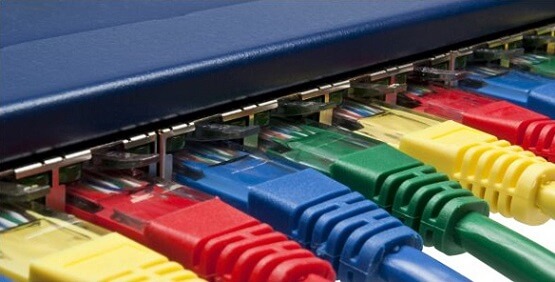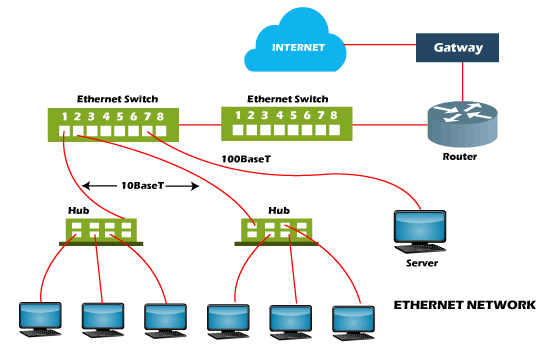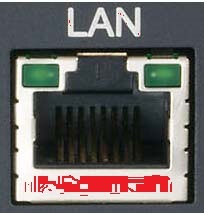What is Ethernet?
Ethernet is a type of communication protocol that is created at Xerox PARC in 1973 by Robert Metcalfe and others, which connects computers on a network over a wired connection. It is a widely used LAN protocol, which is also known as Alto Aloha Network. It connects computers within the local area network and wide area network. Numerous devices like printers and laptops can be connected by LAN and WAN within buildings, homes, and even small neighborhoods.

It offers a simple user interface that helps to connect various devices easily, such as switches, routers, and computers. A local area network (LAN) can be created with the help of a single router and a few Ethernet cables, which enable communication between all linked devices. This is because an Ethernet port is included in your laptop in which one end of a cable is plugged in and connect the other to a router. Ethernet ports are slightly wider, and they look similar to telephone jacks.
With lower-speed Ethernet cables and devices, most of the Ethernet devices are backward compatible. However, the speed of the connection will be as fast as the lowest common denominator. For instance, the computer will only have the potential to forward and receive data at 10 Mbps if you attach a computer with a 10BASE-T NIC to a 100BASE-T network. Also, the maximum data transfer rate will be 100 Mbps if you have a Gigabit Ethernet router and use it to connect the device.
The wireless networks replaced Ethernet in many areas; however, Ethernet is still more common for wired networking. Wi-Fi reduces the need for cabling as it allows the users to connect smartphones or laptops to a network without the required cable. While comparing with Gigabit Ethernet, the faster maximum data transfer rates are provided by the 802.11ac Wi-Fi standard. Still, as compared to a wireless network, wired connections are more secure and are less prone to interference. This is the main reason to still use Ethernet by many businesses and organizations.

Different Types of Ethernet Networks
An Ethernet device with CAT5/CAT6 copper cables is connected to a fiber optic cable through fiber optic media converters. The distance covered by the network is significantly increased by this extension for fiber optic cable. There are some kinds of Ethernet networks, which are discussed below:
- Fast Ethernet: This type of Ethernet is usually supported by a twisted pair or CAT5 cable, which has the potential to transfer or receive data at around100 Mbps. They function at 100Base and 10/100Base Ethernet on the fiber side of the link if any device such as a camera, laptop, or other is connected to a network. The fiber optic cable and twisted pair cable are used by fast Ethernet to create communication. The 100BASE-TX, 100BASE-FX, and 100BASE-T4 are the three categories of Fast Ethernet.
- Gigabit Ethernet: This type of Ethernet network is an upgrade from Fast Ethernet, which uses fiber optic cable and twisted pair cable to create communication. It can transfer data at a rate of 1000 Mbps or 1Gbps. In modern times, gigabit Ethernet is more common. This network type also uses CAT5e or other advanced cables, which can transfer data at a rate of 10 Gbps.
The primary intention of developing the gigabit Ethernet was to full fill the user’s requirements, such as faster transfer of data, faster communication network, and more.
- 10-Gigabit Ethernet: This type of network can transmit data at a rate of 10 Gigabit/second, considered a more advanced and high-speed network. It makes use of CAT6a or CAT7 twisted-pair cables and fiber optic cables as well. This network can be expended up to nearly 10,000 meters with the help of using a fiber optic cable.
- Switch Ethernet: This type of network involves adding switches or hubs, which helps to improve network throughput as each workstation in this network can have its own dedicated 10 Mbps connection instead of sharing the medium. Instead of using a crossover cable, a regular network cable is used when a switch is used in a network. For the latest Ethernet, it supports 1000Mbps to 10 Gbps and 10Mbps to 100Mbps for fast Ethernet.
Advantages of Ethernet
- It is not much costly to form an Ethernet network. As compared to other systems of connecting computers, it is relatively inexpensive.
- Ethernet network provides high security for data as it uses firewalls in terms of data security.
- Also, the Gigabit network allows the users to transmit data at a speed of 1-100Gbps.
- In this network, the quality of the data transfer does maintain.
- In this network, administration and maintenance are easier.
- The latest version of gigabit ethernet and wireless ethernet have the potential to transmit data at the speed of 1-100Gbps.
Disadvantages of Ethernet
- It needs deterministic service; therefore, it is not considered the best for real-time applications.
- The wired Ethernet network restricts you in terms of distances, and it is best for using in short distances.
- If you create a wired ethernet network that needs cables, hubs, switches, routers, they increase the cost of installation.
- Data needs quick transfer in an interactive application, as well as data is very small.
- In ethernet network, any acknowledge is not sent by receiver after accepting a packet.
- If you are planning to set up a wireless Ethernet network, it can be difficult if you have no experience in the network field.
- Comparing with the wired Ethernet network, wireless network is not more secure.
- The full-duplex data communication mode is not supported by the 100Base-T4 version.
- Additionally, finding a problem is very difficult in an Ethernet network (if has), as it is not easy to determine which node or cable is causing the problem.
History of Ethernet
At the beginning of the 1970s, Ethernet was developed over several years from ALOHAnet from the University of Hawaii. Then, a test was performed, which was peaked with a scientific paper in 1976, and published by Metcalfe together with David Boggs. Late in 1977, a patent on this technology was filed by Xerox Corporation.
The Ethernet as a standard was established by companies Xerox, Intel, and Digital Equipment Corporation (DEC); first, these companies were combined to improve Ethernet in 1979, then published the first standard in 1980. Other technologies, including CSMA/CD protocol, were also developed with the help of this process, which later became known as IEEE 802.3. This process also led to creating a token bus (802.4) and token ring (802.5).
In 1983, the IEEE technology became standard, and before 802.11, 802.3 was born. Many modern PCs started to include Ethernet cards on the motherboard, as due to the invention of single-chip Ethernet controllers, the Ethernet card became very inexpensive. Consequently, the use of Ethernet networks in the workplace began by some small companies but still used with the help of telephone-based four-wire lines.
Until the early 1990s, creating the Ethernet connection through twisted pair and fiberoptic cables was not established. That led to the development of the 100 MB/s standard in 1995.
Ethernet standards
There are different standards of Ethernet, which are discussed below with additional information about each of them.
Ethernet II / DIX / 802.3
A studied edition of Ethernet, Ethernet II, also called as DIX. The DIX stands for Digital, Intel, and Xerox. And, 802.3, which is rewritten by Digital Equipment Corp, Xerox, and Intel.
Fast Ethernet / 100BASE-T / 802.3u
Fast Ethernet (100BASE-T or 802.3u) is a communications protocol, which is usually supported by a twisted pair or CAT5 cable.
The 100BASE-T standards have two types. The 100BASE-T is the first standard that makes use of CSMA/CD.
Three different kinds of cable technologies are available with 100BASE-T.
- 100BASE-T4: It is utilized for a network that requires a low-quality twisted-pair on a 100-Mbps Ethernet.
- 100BASE-TX: It makes use of two-wire data grade twisted-pair wire, developed by ANSI 100BASE-TX, which is also called 100BASE-TX and 100BASE-X.
- 100BASE-FX: It uses 2 stands of fiber cable and developed by ANSI.
Gigabit Ethernet / 1000BASE-T / 802.3z / 802.ab
Gigabit Ethernet has the potential to transmit data up to 1 Gbps, which makes use of all four copper wires in category 5, which is also called 1000BASE-T or 802.3z / 802.3ab.
10 Gigabit Ethernet / 802.3ae
10 Gigabit Ethernet (10GE or 10 GbE or 10 GigE) is a new standard that defines only full-duplex point-to-point links. It supports up to 10 Gb/s transmissions that were published in 2002, which is also known as 802.3ae. The hubs, CSMA/CD, and half-duplex operation do not exist in 10 GbE.
How to connect or plug in an Ethernet cable
The process will be the same, whether you are connecting an Ethernet cable to your computer or setting up a home network. As the below image is representing that it appears to be a large telephone cord jack. Once you have located it, then, until you hear a click, you have to push the cable connector into the port. You will see a green light that indicates a signal is found if the connection is properly established on the other end.

Why is Ethernet used?
Ethernet is still a common form of network connection, which is used for its high speed, security, and reliability. It is used to connect devices in a network that is used by specific organizations for local networks, organizations such as school campuses and hospitals, company offices, etc.
As compared to technology such as IBM’s Token Ring, due to Ethernet’s low price, it initially grew popular. As gradually network technology advanced, Ethernet ensured its sustained popularity as it has the potential to develop and deliver higher levels of performance with maintaining backward compatibility. In the mid-1990s, the original ten megabits per second of Ethernet increased to 100 Mbps. Furthermore, up to 400 gigabits per second can be supported by current versions of Ethernet.
How Ethernet Works
The Ethernet, in the OSI model, facilitates the operation of physical and data link layers and resides in the lower layers of the Open Systems Interconnection. There are seven layers available in the OSI model, which are as follow:
- Physical layer
- Data link layer
- Network layer
- Transport layer
- Session layer
- Presentation layer
- Application layer
The application layer is the topmost layer that makes capable of users to download and access data from a mail client or a web browser. Users enter their queries with the help of the application; then, it is sent to the next layer, where the request is known as a “packet.” The information about the sender and the destination web address is contained by the packet. Until the packet is reached the bottom layer, called the Ethernet frame, the packet is transmitted from the application layer. The layer closest to your device is the first or bottom layer.
